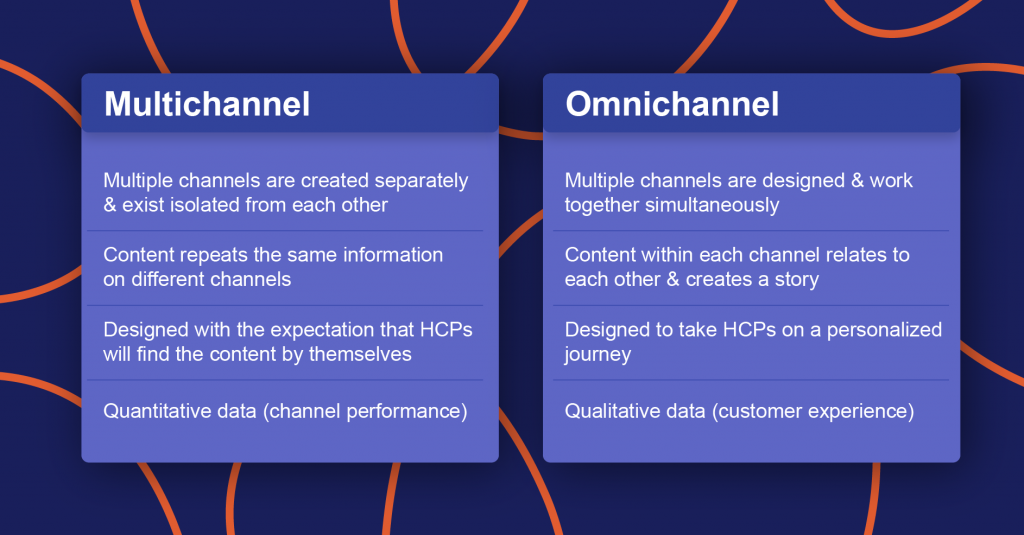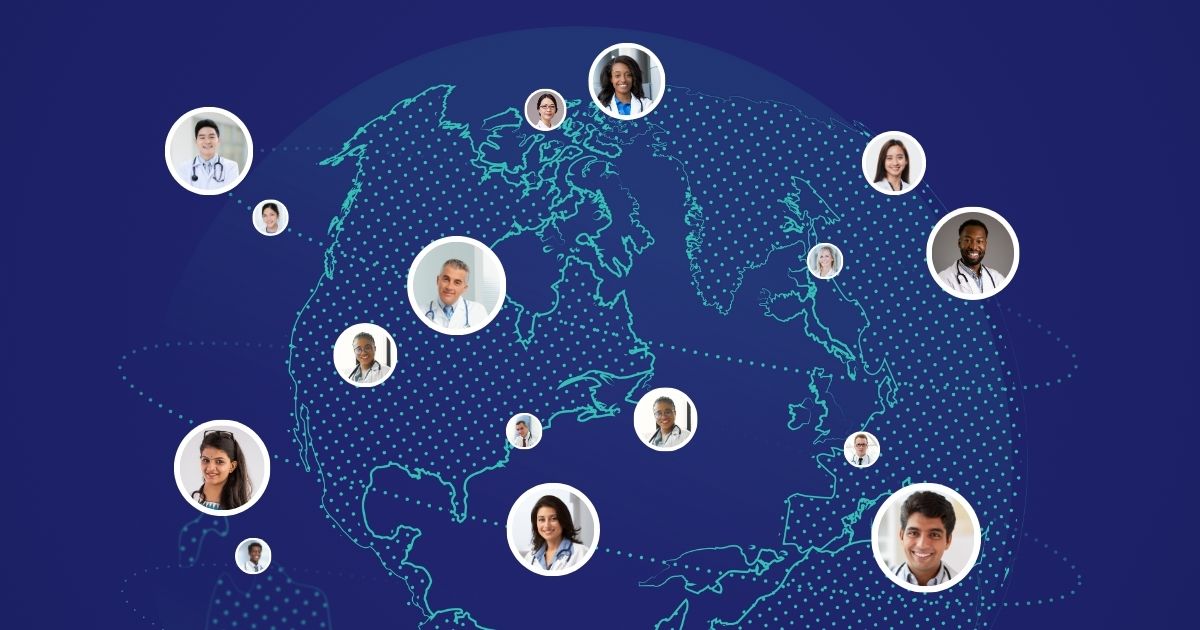
Did you know that 98% of pharmaceutical executives feel it’s important to develop and implement an omnichannel strategy for their company, but only 15% of pharma companies consider their HCP engagement omnichannel?
Implementing omnichannel marketing in pharma can be challenging. There are so many complexities, from truly understanding HCP needs and creating a smooth customer experience to seamlessly integrating your technology stack with your CRM, HCP portal, MAP, and event platform.
That’s why we’ve outlined the 3 essential elements of omnichannel in pharma, 4 design principles for building your omnichannel architecture, and the latest insights into HCP needs to help you craft an engaging customer journey.
This article is based on research from Across Health and session 2 of ‘The Omnichannel HCP Event Engagement Series 2024’ by SpotMe, with insights from James Turnbull (Founder, Camino Communications), Pierre Metrailler (CEO, SpotMe), and Luke Rogers (Director Key Accounts, SpotMe), 3 highly respected individuals in the pharma and events sector.
To watch the event on demand and download the slides, register for our free Life Science Event Insights Hub.
What Is Omnichannel In Pharma?
The biggest challenge in implementing omnichannel in pharma lies in its very definition. Often, the concept of “omnichannel” is misconstrued as a fixed destination. This contributes to its perceived complexity and distance.
But, James Turnbull takes a different view:
“We very much take the approach that omnichannel is a journey. It’s something you’re going through, and there’s a lot of transformation you need to go through. There are a lot of pieces that you need to bring together.”
To support James’ view, Marketing Evolution defines omnichannel marketing as:
“[T]he integration and cooperation of the various channels organizations use to interact with consumers, with the goal of creating a consistent brand experience. This includes physical (e.g. stores) and digital channels (e.g. websites).”
If we apply this definition to the life science and pharma industry, omnichannel strategies are about using the most appropriate channels to attract and engage HCPs. In a way that creates a seamless and fluid customer experience.
In practice, it involves:
- Identifying all the channels HCPs use (personal, non-personal, media, online, offline)
- Defining HCPs’ personal needs
- Creating content that takes HCPs on a journey
- Orchestrating channels and content to give HCPs a curated experience
Are you a life science company looking for the best event technology to help you run successful HCP events? Check out the 9 event platforms we recommend for 2024.
The 3 Key Components Of Omnichannel In Pharma
Omnichannel in pharma is not impossible, it’s a journey. Here are the 4 key components you need to consider when developing a pharma omnichannel strategy:
#1 Relevance
The essence of a successful pharma omnichannel marketing strategy is “right content, right format, right time”. (James Turnbull, Camino)
Tailoring content to your specific HCP audience, whether they are specialist oncologists, general practitioners, or patients, is not just beneficial – it’s vital.
So, the initial step in crafting an effective strategy for omnichannel marketing in pharma is to identify your target audience. Subdividing this audience into specific personas can also be highly beneficial, particularly when your communication requirements are nuanced and diverse. For example, the informational needs of pathologists and oncologists may vary significantly, needing distinct content tailored to each group.
While creating personas may not be essential for every campaign or product launch, they become increasingly important in complex communication landscapes. Segmenting your audience allows for a more targeted approach, ensuring that each subset receives content that is relevant and addresses their specific needs and preferences.
Producing content that meets the needs of your target audience may seem obvious, but it’s startling how often content is created without a clear understanding of its relevance or intended recipients.
Without this central focus on relevance, you risk wasting both time and resources. Therefore, a thorough understanding of your HCP audience’s needs serves as the cornerstone of an effective pharma omnichannel approach.
#2 Connectivity
Successful omnichannel in pharma is not only about content creation; it’s also about connectivity – both getting your HCPs to the content and guiding them beyond it.
One common pitfall with HCP portals, for example, is that they are often a “dead end” in the content journey. While various channels such as social media posts, emails, or field force representatives may successfully direct HCPs to these portals, the journey suddenly stops when they reach a piece of content. You can avoid this missed opportunity for further HCP engagement by including calls to action, such as invitations for deeper dives into content or webinar sign-ups.
Connectivity is a two-way street; it encompasses both the inbound and outbound interactions with content. For instance, data should flow seamlessly between platforms, whether it be from your website to your CRM system like Veeva or between your event portal and email campaigns.
“Nobody’s entire ecosystem is completely connected. But that’s fine. You can still be omnichannel if you have most things connected up. Getting to that holy grail of every piece having the right piece of data and your customers’ entire profiles moving seamlessly between platforms, is very difficult. But that’s not to say it’s impossible. It’s about getting towards that point of connectivity.”
So, while achieving perfect connectivity in an omnichannel ecosystem is a complex task, it’s not an unattainable goal. And the objective is not necessarily to have an entirely connected ecosystem immediately but to progress toward that ideal.
Luke Rogers believes that omnichannel connectivity can also help when it comes to events:
“When there is more connectivity, it’s easier for event and congress teams to show the ROI of their event activities because it leads to the next steps and an element of measurability and impact. So it adds value to the event function when it’s tied into the omnichannel team.”
#3 Measurement
The rise of digital channels have undoubtedly accelerated the push towards omnichannel in pharma. While digital platforms offer easier measurability, not all metrics are equally valuable. For instance, website views, while simple to track, may not offer deep insights into HCP behavior or sales conversion.
So, it’s key to look at measurement within a broader context of the HCP journey, whether that journey is oriented towards sales, education, or other objectives.
“Your measurement connects to your omnichannel journey. How are you measuring? How are your customers moving through either a sales funnel or an educational funnel or whatever your ultimate goal is? What are the measurements that are happening through the emails and the websites and all the different channels?”
Metrics should be coherent and interrelated across all channels, from emails to websites. Simply counting the number of emails read or website visits won’t directly indicate, for instance, an increase in drug sales. But, these metrics become meaningful when integrated into a larger framework that aligns with your ultimate business goals.
Every touchpoint along the customer journey should be individually measurable and interpreted within a holistic framework. By doing so, you move closer to realizing the overarching objectives – be it higher sales, greater HCP engagement, or improved educational outreach. This nuanced approach to measurement highlights the need for a well-coordinated, interconnected pharma omnichannel marketing strategy.
An Example Of Measurement In Practice (by James Turnbull, Camino)
We had projects earlier this year that were focused on driving testing for a rare condition. The rate of testing served as a clear parallel to prescription rates for treatment. So that became the marker for success. If we saw testing rates going up, we considered the campaign successful.
Every communication that happened – surveys, emails, website content, webinar follow-up, and subscriptions – from start to finish, was aligned with that ultimate goal. And we studied how the metrics could indicate a potential increase in testing.
After monitoring the measurements for 6 months, it was easy to see that testing rates had increased, validating our campaign.
The great thing about tracking these measurements throughout the project was that we could see we were hitting other markers and were on track to achieving our goal. And we could adjust things that weren’t working as we went along.
This project showed us the importance of measuring success across both the HCP journey and the timeline.
Omnichannel Pharma vs Multichannel Pharma
Be careful. Omnichannel marketing in pharma is not the same as multichannel marketing in pharma.
Multichannel marketing for pharma is fragmented and siloed. Omnichannel marketing for pharma, on the other hand, is integrated and logical.
Here are some key differences:
Overall, using omnichannel strategies for pharma instead of multichannel marketing results in a more enjoyable and useful experience for HCPs.
They don’t receive the same information repeatedly on many different channels. Instead, content is relevant and connected. They feel like they are at the center of your communication and can easily follow messages that naturally flow from each other.
Let’s dive into the 4 design principles to follow when moving from a multichannel to an omnichannel strategy in pharma:
Omnichannel Marketing In Pharma: 4 Key Design Principles
A crucial part of omnichannel in pharma is fitting new systems into your already existing technology architecture and making sure they work seamlessly together. Here are the 4 key systems you need for successful omnichannel in pharma:
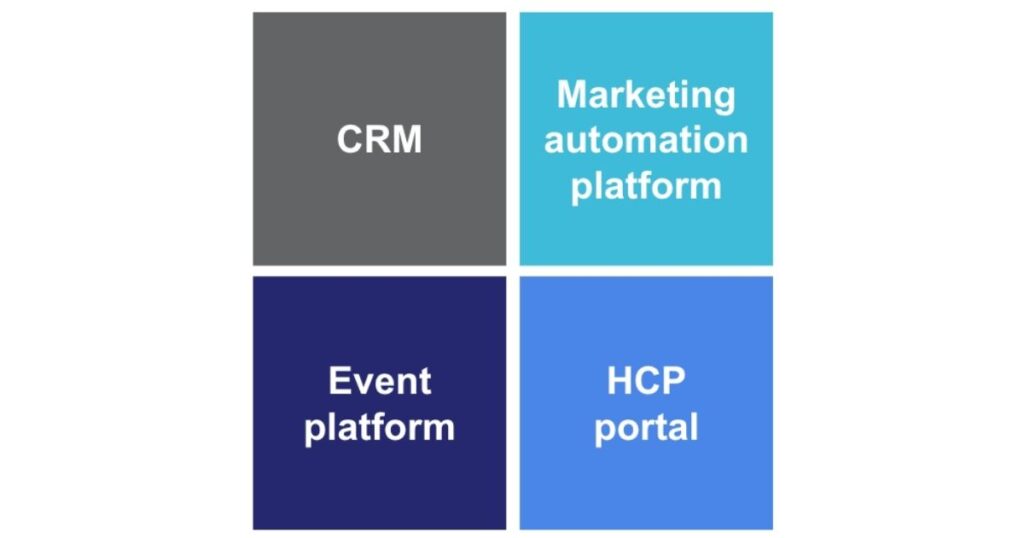
And here are the 4 design principles to consider when developing your pharma omnichannel strategy:
#1 Single Source Of Truth (SSOT)
It is key to establish a “Single Source of Truth.” Pharma companies often have a well-established CRM and HCP portal, among other technologies. But things may start to get complicated when you try to bring in more technologies, such as a life science event platform.
That’s why Pierre Metrailler (SpotMe) and his team recommend conducting a technology inventory to cluster your existing technologies. This especially helps in the context of events, as it is not always clear which systems you should be integrating with.
Based on this inventory, the SpotMe team guide clients in selecting their Single Source of Truth. While this is often the CRM, it’s not universally the case. Therefore, it’s crucial to choose a source that aligns with your specific needs.
Below is a template you can use for your technology inventory and clustering. It helps you determine the reference data for event interactions within your pharma omnichannel strategy. Key considerations include approval processes for events, budget allocations, etc.
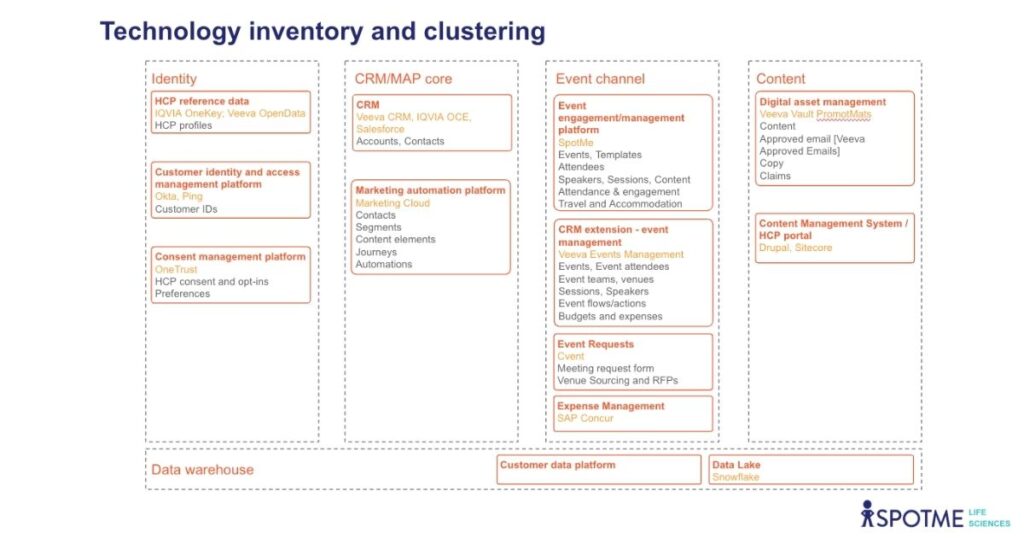
In the current market, many pharma companies layer their event management systems on top of their existing CRM. Whether it’s Veeva CRM with Veeva Events Management or Salesforce with a vanilla implementation, the CRM often serves as the nucleus for event tracking.
#2 Customer Experience (CX) Eats Architecture For Breakfast
At the heart of any architectural design must be the CX. If an architecture doesn’t serve your CX effectively, it becomes questionable, regardless of how robust or comprehensive it may appear from the outset.
A common pitfall in pharmaceutical omnichannel strategies occurs when an organization’s IT department or external consultants create an architectural design that looks excellent on paper but fails to deliver a satisfactory user experience in practice.
“I always give the example of how an HCP gets invited to a webinar. They sign up for the webinar, but because your integration is not optimal, they keep getting emails from your email marketing automation platform asking them to register because it doesn’t know that they’ve already registered.”
Your omnichannel architecture should not only support your design and data goals but must also focus on providing an exceptional user experience. If your existing structure doesn’t meet this criterion, it may be time to revisit and reevaluate your pharma omnichannel strategy.
#3 Don’t Capture The Flag
The “first mover” in a pharma company’s technology stack can set the stage for the entire omnichannel strategy, which can be a problem if the initial system isn’t robust or well-suited to meet evolving needs. When it comes to HCP portals or any other platform, the question of how scalable and relational the database is becomes critical, especially as pharma companies seek to capture richer data from activities like events.
“Pharma companies approach us asking how to integrate an event platform into their omnichannel stack. And we often look at the stack and ask, ‘What happened here?’ The response is usually: whoever came first made the design decision based on what they knew, and other people then continued to build around it. But we believe that building everything around an HCP portal so that it becomes a single source of truth may not be the best option. Because if you expand, especially with an event platform – which is very rich in terms of data – you need a robust single source of truth. That’s why we always recommend your CRM to be your single source of truth.”
Challenging consultants or internal stakeholders about the architectural decisions they’re making is not only reasonable but essential for successful omnichannel in pharma. By asking questions like, “Is the system we are building around truly robust and scalable?” you are more likely to create a well-integrated, effective pharma omnichannel strategy. Consultants or stakeholders should be prepared to provide an honest and insightful answer to such an important question.
#4 CRM+MAP Sandwich
For years, SpotMe customers have been asking Pierre, “Can we integrate your event platform with Veeva?”, “Can we integrate it with IQVIA?” Of course, the answer is yes. But according to his research, this is not always what people in the field or marketing team wants.
This is because while CRM systems remain integral for bottom-of-the-funnel activities and customer retention, their use at the top-of-the-funnel phase can be somewhat limited. Marketing automation platforms (MAPs), on the other hand, are more agile and suitable for mass outreach and engagement, which are vital during the initial phases of customer interaction.
Many pharma companies make the mistake of having a kind of tunnel vision that focuses too heavily on either their CRM or MAP, failing to capitalize on the unique strengths of both. But, remember that each platform has its distinct advantages that contribute to different stages of the customer lifecycle.
By integrating both a CRM and a MAP, you have a more comprehensive, agile solution. The MAP can handle the initial outreach and registration for an event, aiming to maximize reach and sign-ups. Then, the CRM can step in for post-event engagement, providing insights for the “next best action”, based on the collected data and customer interactions.
This balanced approach not only enriches the dataset but also enhances customer experience by ensuring that engagement is both broad and deep. It’s not a question of choosing one over the other but rather integrating both to cover all phases of the customer journey effectively. This dual integration is likely the most efficient and effective way to manage customer relationships across various pharma omnichannel touchpoints.
Omnichannel Pharma Examples
Now you know what omnichannel is and we’ve been through the key components and more technical aspects of setting up an effective omnichannel architecture, let’s simplify things.
Here’s a specific example of omnichannel in pharma:
- A cancer HCP receives an approved email about a new method in breast cancer treatment.
- The HCP clicks a CTA that takes them to a website landing page with more information about the new method.
- The HCP gets an invitation to an e-detailing session with a rep or MSL to discuss the new method.
- At the end of the session, the rep or MSL invites the HCP to a webinar in which a KOL will discuss the new method.
Although this is a very simplified version, you can clearly see the smooth omnichannel journey that all starts from meeting a specific HCP’s needs and builds up over time to give them exactly what they want.
But how can you know what the HCPs you are targeting need?
For more information on engaging HCPs and KOLs at meetings, check out the ultimate KOL engagement plan for successful pharma events.
How HCP Needs Can Drive Pharma Omnichannel
The ‘Digital Native HCPs’
It’s the era of the ‘digital native HCPs’ – those who studied and qualified from medical school during the digital age. As you can imagine, that means they are used to receiving and absorbing information digitally.
Given that there are fewer and fewer ‘digital immigrants’ (HCPs who studied before the internet existed), these ‘digital native HCPs’ are the future (and have been since 2014).
So, it’s crucial to put yourself in their shoes and understand how they want to learn and absorb a stack of ever-changing information before putting it into practice to benefit their patients’ health.
To put the ‘digital native HCPs’ desires into perspective, take a look at this research from Across Health Navigator365:
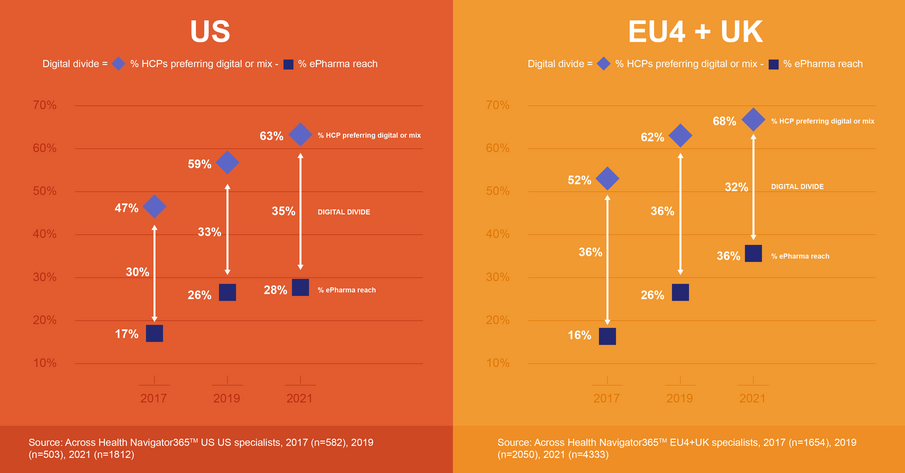
The graphs show the large gap between what HCPs want vs what they actually get from pharma. The reason why this gap has hardly changed over the past few years is that reach and HCPs’ preference for digital learning have both increased.
These findings show how important it is for the pharmaceutical industry to invest in digital channels that create a seamless omnichannel journey.
The Type Of Medical Educational Content HCPs Prefer
HCPs receive large amounts of medical educational content every day. On hundreds of different channels – “thanks to” digitization.
So, if you present information to HCPs in a way that’s long-winded and difficult to digest, your pharma omnichannel strategy will not be effective. And you will fail to stand out from the competition.
Here’s how to grab and keep HCPs’ attention with your content:
Send short messages
Imagine you’re an HCP and you receive a 500-word approved email about new research into autoimmune diseases. They woulndn’t have the time to read it. You need to catch their eye in 7 seconds or less.
That means creating short teasers with a snapshot of information. Instead of a 500-word email, send an infographic or an image with a few lines of text. Especially if it’s your first communication with the HCP.
Increase personalization
HCPs have access to thousands of sources of information anywhere at any time – news websites, Google, online communities, digital journals, etc. But none of this information is customized to them.
If you can tap into individual HCP’s needs and tailor messages to them, you will not only grab their attention, but you will keep it. And they will absorb your message more willingly.
Add personalized engagement to your KPIs for your omnichannel strategy for pharma.
Looking for a MedComms agency to help you with your event content? Check out our list of the top medical communications companies.
How HCPs Learn
Everyone has a particular way of learning things most effectively. And perhaps even a specific time of the day when they learn more. HCPs are no different. And you need to take this into account when creating content for your pharma omnichannel strategy.
As mentioned above, each piece of content should connect and tell a story. And like any story, it needs to be unforgettable (for the right reasons). So, to ensure HCPs don’t forget your story, your content should appeal to a range of different learning styles.
Here’s an infographic that clearly shows how you can adapt to various learning styles using different channels:
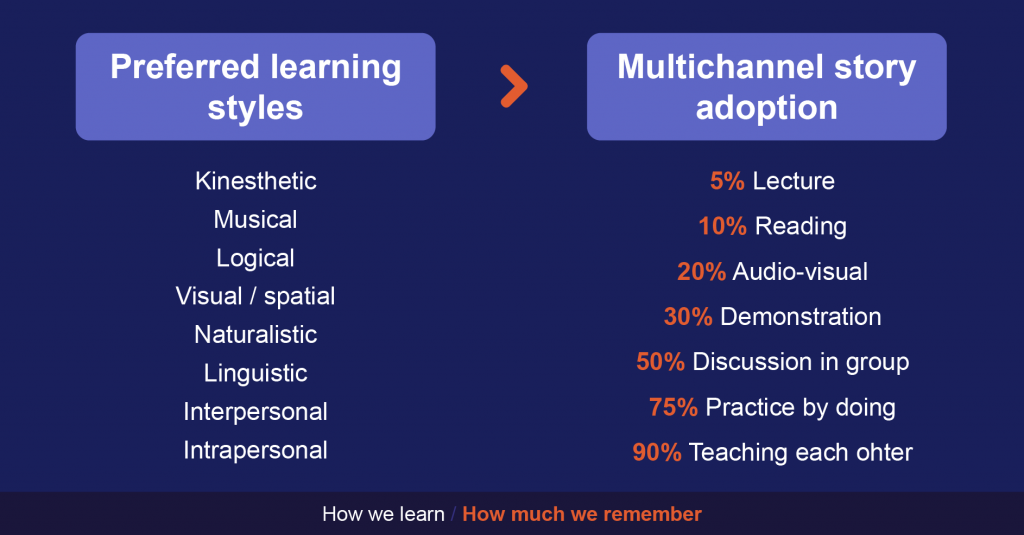
The wide variety of learning styles illustrates that a one-size-fits-all approach in your pharma omnichannel marketing is not the way to go.
HCPs’ need for medical education is always increasing. And their preference for personalized content and exceptional customer experiences through digital channels is too.
Given that medical educational content is already proving to be a huge success, this trend will not stop. HCPs will seek content from pharma companies that offer them the seamless experience they crave through omnichannel strategies.
So, to reach more HCPs on a global scale and have a higher impact on the future of medicine, it is well worth investing the time, effort, and budget into learning digital skills and integrating your omnichannel architecture – CRM, MAP, HCP portal, event platform.
If you’re a life science company looking for the latest HCP engagement trends, check out HCP engagement: emerging trends, success metrics, and omnichannel strategies.
What To Consider When Planning Your Pharma Omnichannel Strategy
Every day, HCPs search for medical content to help them expand their knowledge to assess, treat, and manage patients to the best of their ability.
So, when planning your pharma omnichannel marketing strategy, you should:
- Ensure HCPs can easily find what they need when they want it
- Give HCPs interactive experiences that help them consolidate material
- Provide HCPs with the latest information specific to their area of expertise
- Send HCPs material that helps them answer questions at the point of care
- Make content accessible on demand, so they can learn when it suits them
- Use multiple digital channels to meet different HCP needs & learning styles (& create measurable KPIs for each channel)
- Get your content endorsed by recognized leading experts in their field
- Create optimized content that is relevant to a specific HCP audience
- Produce bite-sized material for initial engagement and in-depth material for engagement later on
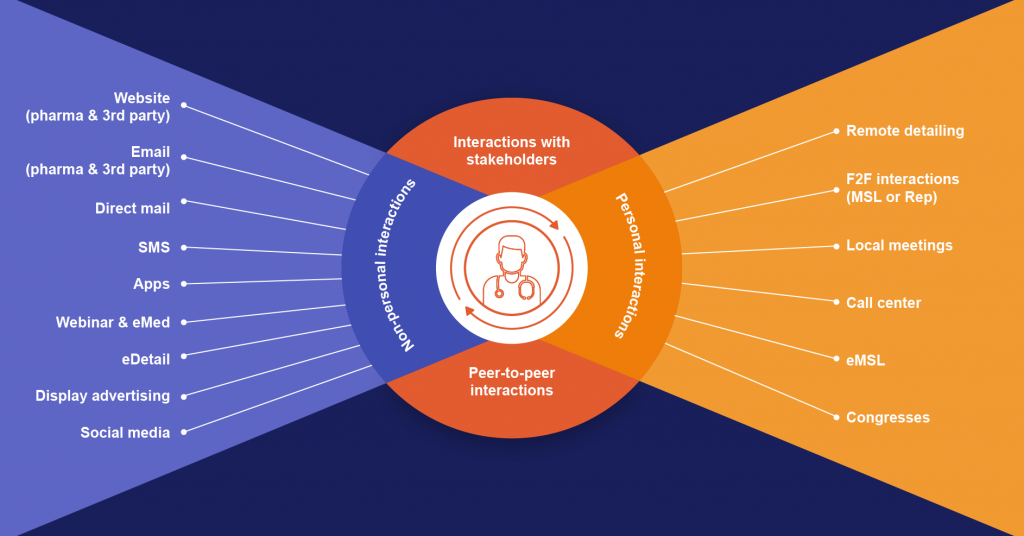
What Channels To Include In Your Pharma Omnichannel Marketing Strategy
According to James Turnbull (Camino), the term “channel preference” can be somewhat misleading, especially when gauging HCPs’ opinions. Survey data often reveals that pharma-generated content ranks low in preferred channels among HCPs. However, the word “preference” may imply a level of deliberate choice that doesn’t accurately reflect how individuals consume content.
People don’t usually ponder their “preferred” channels when seeking information; they simply use convenient and familiar platforms like search engines, websites, social media, or podcasts. The focus should, therefore, not be solely on channel “preference” but on ensuring that your content is accessible and relevant across multiple platforms where your audience naturally gravitates.
So, while a multi-channel approach is key, the emphasis should be on content relevance and availability across a variety of platforms, rather than narrowing down to what might be considered “preferred” channels.
Having said that, there’s no doubt that events are one of the most effective ways to engage with and build relationships with HCPs. And thanks to today’s event technology, delivering events in various formats to reach HCPs on a global scale and collecting valuable first-party data has never been easier.
Here are some examples of events to include in your omnichannel mix:
- Congresses
- Advisory boards
- Investigator meetings
- Satellite symposia
- Medical standalones
- Medical conferences
The Event Platform To Add To Your Pharma Omnichannel Stack
Implementing omnichannel in pharma is vital if you want to build meaningful, longlasting relationships with HCPs. And events are one of the most effective channels in your omnichannel HCP journey. But which event platform can help you achieve your goals?
SpotMe is a fully compliant, end-to-end, life science event platform that has countless ways to interact with HCPs, as well as deep native integrations with leading pharma CRMs such as Veeva and IQVIA, as well as MAPs, such as Salesforce.
Trusted by 10 out of the top 20 top life science and pharma companies, such as J&J, Roche, Sanofij, and GSK, SpotMe is the missing piece of your pharma omnichannel strategy.
To find out how SpotMe can help you achieve your omnichannel goals, request a demo now.
Resources
- Session 2 of ‘The Omnichannel HCP Event Engagement Series 2024’ by SpotMe, with insights from James Turnbull (Founder, Camino Communications), Pierre Metrailler (CEO, SpotMe), and Luke Rogers (Director Key Accounts, SpotMe)
- Evidence-based omnichannel – Delighting pharma customers in the omnichannel age by Across Health
- What is omnichannel marketing? Definition, tips, and examples by Marketing Evolution
- The State of Omnichannel HCP Engagement in Pharma by Aktana
- The Future Of HCP Engagement: Closing The Gaps Between Healthcare Professional Demand And Pharmaceutical Industry Supply Of Medical Information by EPG Health





